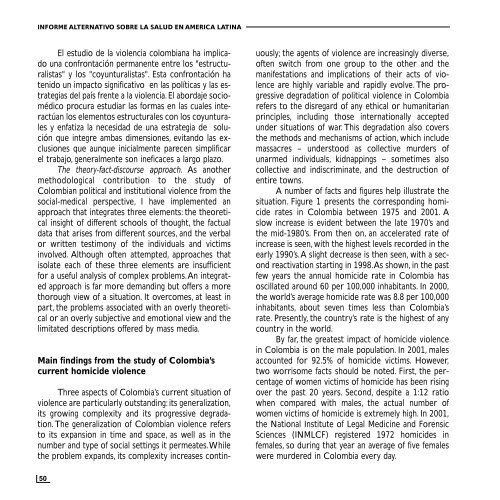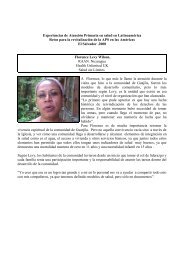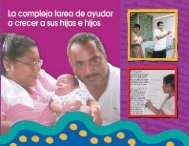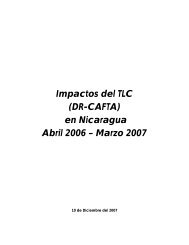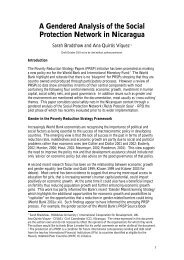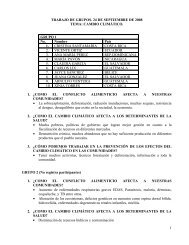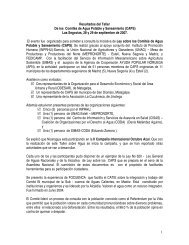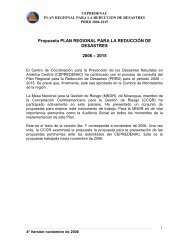Download - CISAS | Centro de Información y Servicios de AsesorÃa ...
Download - CISAS | Centro de Información y Servicios de AsesorÃa ...
Download - CISAS | Centro de Información y Servicios de AsesorÃa ...
You also want an ePaper? Increase the reach of your titles
YUMPU automatically turns print PDFs into web optimized ePapers that Google loves.
INFORME ALTERNATIVO SOBRE LA SALUD EN AMERICA LATINAEl estudio <strong>de</strong> la violencia colombiana ha implicadouna confrontación permanente entre los "estructuralistas"y los "coyunturalistas". Esta confrontación hatenido un impacto significativo en las políticas y las estrategias<strong>de</strong>l país frente a la violencia. El abordaje sociomédicoprocura estudiar las formas en las cuales interactúanlos elementos estructurales con los coyunturalesy enfatiza la necesidad <strong>de</strong> una estrategia <strong>de</strong> soluciónque integre ambas dimensiones, evitando las exclusionesque aunque inicialmente parecen simplificarel trabajo, generalmente son ineficaces a largo plazo.The theory-fact-discourse approach. As anothermethodological contribution to the study ofColombian political and institutional violence from thesocial-medical perspective, I have implemented anapproach that integrates three elements: the theoreticalinsight of different schools of thought, the factualdata that arises from different sources, and the verbalor written testimony of the individuals and victimsinvolved. Although often attempted, approaches thatisolate each of these three elements are insufficientfor a useful analysis of complex problems.An integratedapproach is far more <strong>de</strong>manding but offers a morethorough view of a situation. It overcomes, at least inpart, the problems associated with an overly theoreticalor an overly subjective and emotional view and thelimitated <strong>de</strong>scriptions offered by mass media.Main findings from the study of Colombia’scurrent homici<strong>de</strong> violenceThree aspects of Colombia’s current situation ofviolence are particularly outstanding: its generalization,its growing complexity and its progressive <strong>de</strong>gradation.The generalization of Colombian violence refersto its expansion in time and space, as well as in thenumber and type of social settings it permeates.Whilethe problem expands, its complexity increases continuously;the agents of violence are increasingly diverse,often switch from one group to the other and themanifestations and implications of their acts of violenceare highly variable and rapidly evolve. The progressive<strong>de</strong>gradation of political violence in Colombiarefers to the disregard of any ethical or humanitarianprinciples, including those internationally acceptedun<strong>de</strong>r situations of war. This <strong>de</strong>gradation also coversthe methods and mechanisms of action, which inclu<strong>de</strong>massacres – un<strong>de</strong>rstood as collective mur<strong>de</strong>rs ofunarmed individuals, kidnappings – sometimes alsocollective and indiscriminate, and the <strong>de</strong>struction ofentire towns.A number of facts and figures help illustrate thesituation. Figure 1 presents the corresponding homici<strong>de</strong>rates in Colombia between 1975 and 2001. Aslow increase is evi<strong>de</strong>nt between the late 1970’s andthe mid-1980’s. From then on, an accelerated rate ofincrease is seen, with the highest levels recor<strong>de</strong>d in theearly 1990’s.A slight <strong>de</strong>crease is then seen, with a secondreactivation starting in 1998.As shown, in the pastfew years the annual homici<strong>de</strong> rate in Colombia hasoscillated around 60 per 100,000 inhabitants. In 2000,the world’s average homici<strong>de</strong> rate was 8.8 per 100,000inhabitants, about seven times less than Colombia’srate. Presently, the country’s rate is the highest of anycountry in the world.By far, the greatest impact of homici<strong>de</strong> violencein Colombia is on the male population. In 2001, malesaccounted for 92.5% of homici<strong>de</strong> victims. However,two worrisome facts should be noted. First, the percentageof women victims of homici<strong>de</strong> has been risingover the past 20 years. Second, <strong>de</strong>spite a 1:12 ratiowhen compared with males, the actual number ofwomen victims of homici<strong>de</strong> is extremely high. In 2001,the National Institute of Legal Medicine and ForensicSciences (INMLCF) registered 1972 homici<strong>de</strong>s infemales, so during that year an average of five femaleswere mur<strong>de</strong>red in Colombia every day.50


